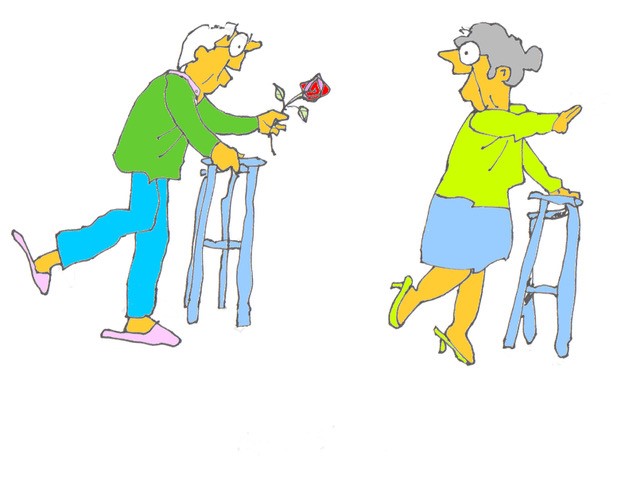FRAILTY PART 3
Age and Physical fitness
Cardiorespiratory fitness increases through childhood to reach its peak by late teens to early twenties. But once you have a sitting down a job it starts to decline and does so steadily over the next few decades – by between 1 and 2% a year. The decline accelerates after the age of about 70.
The progressive loss of aerobic capacity is inevitable but the rate of loss is much slower in people who maintain a regular exercise pattern. This graph illustrates the difference between regular exercisers and those of a more sedentary habit.

Physical fitness and independence
The functional ability of the fit person is always greater than that of his/her unfit peer. This does not matter much until later in life when the physical capacity may descend to a level at which it is difficult to perform daily activities – those everyday exertions which are necessary for independent living. The unfit person will reach this point at a much earlier age than the fit.

We can only maintain independence if our ability is maintained above a certain level, shown on the graph as the horizontal line. The less able we are, the earlier in life do we hit that line. The fitter we are the less likely we are ever to reach this line.
The effect of intercurrent illness
It gets worse. The frail elderly are particularly vulnerable to acute deterioration in health mainly due to falls, fractures, and infections. Such events lead to a sudden steepening of the curve of loss of function so that the line of dependency is reached much earlier

Going into hospital
And worse still is to come – hospitalisation. In the hospital, immobility is the rule, a result of both of the reason for admission and of the usual hospital culture of bed rest for poorly patients. Staff concern about patient safety means that they discourage patients from taking independent activity. The result is further detraining. Unfortunately the frail elderly not only start with reduced muscle mass and strength but also, when bed-rested, suffer a more rapid further loss than younger subjects. For many, this is the last straw in their goal of maintaining independence. They become stuck in hospital awaiting long-term care which can be hard to find.
Making hospitals less dangerous
This disastrous progression of illness to increasing disability can be partly ameliorated by planned in-patient exercise programmes. These are now being implemented in many geriatric departments with some success but need to be spread more widely to ensure a rapid recovery as possible in surgical wards. The main obstruction to the full implementation of in-patient habilitation is the lack of staff. There are not enough nurses/care assistants to supervise unsteady elderly patients moving about the ward and not enough physiotherapists to help them to increase their activity levels. With the NHS being as cash-strapped as it is, it may take many decades to reduce the detraining effect of hospital admission. In the meantime, getting the patient home as quickly as possible is probably the best solution.
Healthspan versus Lifespan
The health of nations is often measured by the average Lifespan. For me it is Healthspan that is far more important – the length of life unimpeded by disease and disability. The key to increasing both Healthspan and Lifespan is a regular physical activity and I will be tackling this subject next week…….
Apology
I am very sorry that for many months there has been a problem with this Blog. A large proportion of subscribers has not been receiving regular notification of the weekly Blog. In an attempt to rectify this I managed to disable the website completely so that the Blog became unobtainable. Very many thanks to Sanzen’s technical administrator and to Mandi of Pink Spaghetti for rescuing me from my incompetence. With their help, I hope that this Blog is now reaching all the subscribers.
Subscribe to the blog
Categories
- Accelerometer
- Alzheimer's disease
- Blood pressure
- BMI
- Cancer
- Complications
- Coronary disease
- Cycling
- Dementia
- Diabetes
- Events
- Evidence
- Exercise promotion
- Frailty
- Healthspan
- Hearty News
- Hypertension
- Ill effects
- Infections
- Lifespan
- Lipids
- Lung disease
- Mental health
- Mental health
- Muscles
- Obesity
- Osteoporosis
- Oxygen uptake
- Parkinson's Disease
- Physical activity
- Physical fitness
- Pregnancy
- Running
- Sedentary behaviour
- Strength training
- Stroke
- Uncategorized
- Walking



I believe it was Mark Twain who said that bed was the most dangerous place, more people die there than anywhere else.
Surely when one is in the hospital we are there for a good reason. To recover from whatever ailment we are suffering requires the skills of the medical team which includes bed rest. Only AFTER we are fit to leave the hospital should we consider a fitness regime?
Thanks Thom. Admission to hospital does not necessarily demand bed rest. However all too often being in hospital involves more time in bed or sitting in a chair than is necessary. I am not advocating in-hospital fitness training, just reasonable activity to try to prevent the in-patient detraining effect which can take many weeks to reverse. Hugh
Love all the info – keep it coming Hugh !